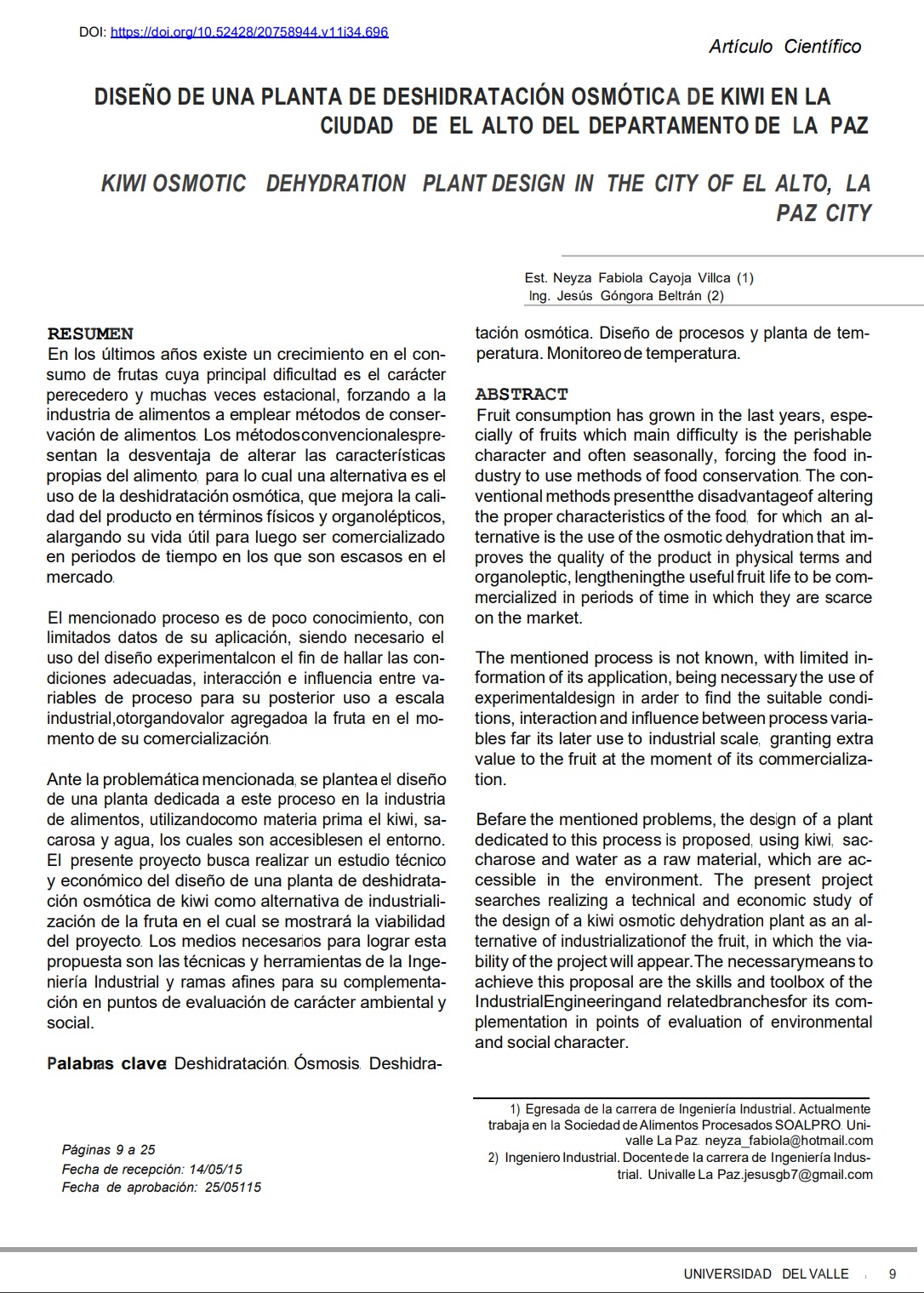Kiwi Osmotic Dehydration Plant Design in the City of El Alto, La Paz City
DOI:
https://doi.org/10.52428/20758944.v11i34.696Keywords:
Dehydration, Osmosis, Osmotic dehydration, Process and plant design, Temperature monitoringAbstract
Fruit consumption has grown in the last years, especially of fruits which main difficulty is the perishable character and often seasonally, forcing the food industry to use methods of food conservation. The conventional methods present the disadvantage of altering the proper characteristics of the food, for which an alternative is the use of the osmotic dehydration that improves the quality of the product in physical terms and organoleptic, lengthening the useful fruit life to be commercialized in periods of time in which they are scarce on the market. The mentioned process is not known, with limited information of its application, being necessary the use of experimental design in arder to find the suitable conditions, interaction and influence between process variables far its later use to industrial scale, granting extra value to the fruit at the moment of its commercialization. Befare the mentioned problems, the design of a plant dedicated to this process is proposed, using kiwi, saccharose and water as a raw material, which are accessible in the environment. The present project searches realizing a technical and economic study of the design of a kiwi osmotic dehydration plant as an alternative of industrialization of the fruit, in which the viability of the project will appear. The necessary means to achieve this proposal are the skills and toolbox of the Industrial Engineering and related branches for its complementation in points of evaluation of environmental and social character.
Downloads
References
(1) EROSKI, Escuelas Idea Sana Septiembre Octubre "Kiwi, concentrado de vitaminas", Chile.
(2) INSTITUTO NACIONAL DE ESTADÍSTICA. 2015.
(3) GIREN, Publicación Nº 73 (1988, Diciembre) Manual del cultivo del KIWI (Actinidia chinensis)
(4) SIERRA, A., (201 O). Estudio de la deshidratación osmótica de la arveja china (pisumsativuml.) mediante dos metodologías, directa e indirecta, como alternativa tecnológica al sector hortofrutícola del país. Tesis licenciatura Facultad de Ingeniería Universidad de San Carlos de Guatemala.
(5) PARZANESE, M., Deshidratación Osmótica, Tecnologías para la Industria Alimentaria. Argentina.
(6) CORNEJO, V., (201 O). Deshidratación de rebanadas de aguacate variedad Hasspor el método OSMO•VAC (osmótico•vació) y evaluación de calidad. Tesis. Maestría. Instituto politécnico nacional. México DF.
(7) SABLANI Y RAHMAN, 2003; van Nieuwen huijzen et al., 2001.

Downloads
Published
How to Cite
Issue
Section
License
Copyright (c) 2015 Neyza Fabiola Cayoja Villca y Jesús Góngora Beltrán

This work is licensed under a Creative Commons Attribution 4.0 International License.
Authors who publish with this journal agree to the following terms:
- Authors retain copyright and grant the journal right of first publication with the work simultaneously licensed under a Creative Commons Attribution License 4.0 that allows others to share the work with an acknowledgement of the work's authorship and initial publication in this journal.
- Authors are able to enter into separate, additional contractual arrangements for the non-exclusive distribution of the journal's published version of the work (e.g., post it to an institutional repository or publish it in a book), with an acknowledgement of its initial publication in this journal.
- Authors are permitted and encouraged to post their work online (e.g., in institutional repositories or on their website) prior to and during the submission process, as it can lead to productive exchanges, as well as earlier and greater citation of published work.














